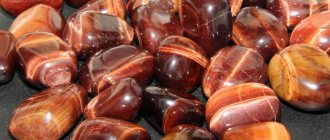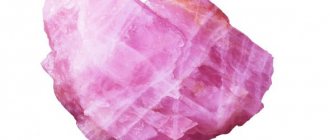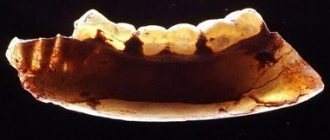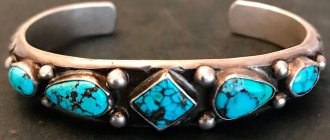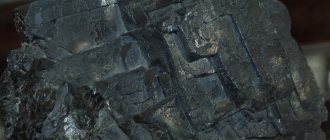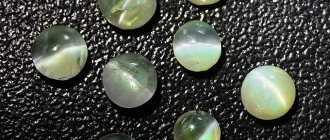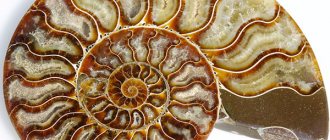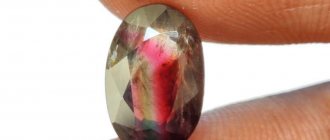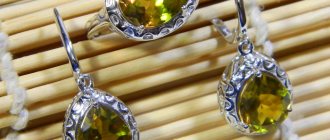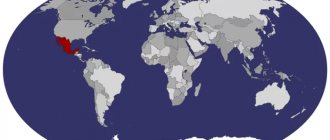Pearls are a waste product of mollusks, obtained from the inside of shells. When a foreign body enters the shell, the animal actively produces nacre, which envelops the grain of sand. After a few years, white, black, gray, golden and even pink pearls are obtained. According to global standards, classification is carried out according to shape, color, size and origin.
Types of sea pearls
The shape and color of the minerals depend on the type of mollusk and the environment in which the oysters live.
The correct shape is considered to be a sphere, but it is extremely rare. There are hemispherical and “rice” (oval with pointed ends) forms, which are also close to ideal and highly valued. You can often see examples of irregular outlines (sometimes of an abstract appearance), for example, Baroque or semi-Baroque pearls with asymmetrical edges.
The precious black mineral is rarely found in nature and is cultivated on the shores of the Pacific Ocean. In addition, beads of marine origin have white, blue, green, cream, gold and other tones.
The most famous cultured pearls are Chinese and Thai. There are many farms in Thailand and China where specimens of all shades are grown artificially. These countries are the largest exporters of cultured pearls.
White, pink, cream
“Wild” sea beads are most often painted in pastel colors. With the development of pearl farms, the extraction of the natural mineral decreased significantly, which automatically increased its price. A string of real sea stone costs at least a thousand dollars, regardless of color or shape.
Very valuable pink and white pearls are cultivated on the Japanese islands of Honshu and Kyushu and in China. The oyster in which the beads are grown is called Akoya-kai in Japanese, hence the name of the species, Akoya. General characteristics of the variety:
- Color: white, pinkish, cream and champagne.
- The size of the beads is 2-8 mm in diameter. There are pearls with a diameter of 11 mm, this depends on the size of the oyster.
- The standard shape is round or baroque.
A special feature is the bright shine. In strong light, the beads sparkle and shimmer in different colors. Because of this, Akoya is sometimes called the rainbow pearl.
Cortez
The precious black Cortez variety was mined on the northwestern coast of Mexico. It is produced by the mollusks Pinetada mazatlanica and Pteria sterna. Their only habitat is the Gulf of California, also known as the Sea of Cortez.
Due to the threat of extinction of these species of mollusks, a ban on their fishing has been introduced: the production of natural “Black Beauty” has been stopped. However, since the early 1990s, the beads have been grown on a special farm in Mexico.
Cortez pearls are called the jewel of monarchs. Due to its high aesthetic properties, it is a favorite decoration of royalty, aristocrats and celebrities.
Basic properties:
- Pearl size is from 8 to 14 mm.
- Color is predominantly brown, gray with a silver or black tint. There are also golden pearls.
- A characteristic feature is its spherical shape and chic shine. Less common are irregularly shaped black beads.
Pearls of Tahiti
This variety is cultivated in French Polynesia, the center is located on the island of Tahiti.
Black pearls are produced by Pinctada margaritifera oysters, also called black-lipped oysters. The size of the mollusks is up to 30 cm, which makes the beads large.
Other characteristics:
- Size - within 8-18 mm. Some specimens reach 20 mm.
- The color range includes gray, purple, green, brown, black.
- The Tahiti variety is characterized by a round, oval, baroque, teardrop shape.
- A distinctive feature is the metallic sheen of the pearls.
Keshi – mother-of-pearl “grains”
This is what keshi is called “grains” in Japanese. Small shimmering organic pebbles appear in the bodies of freshwater and sea oysters as “side effects.” The beads were first discovered in a shell after a failed grafting. Despite the fact that the oyster was unable to establish the process of enveloping the main core with nacre, the process was launched for small particles that naturally penetrated inside the pearl sac.
Such pearls are not specially cultivated, despite the fact that they are quite expensive, although they are inferior in price to larger “loose” beads. No one can predict the shape and size of Keshi pearls. They can be either flattened, resembling flower petals, or round or of any irregular shape.
Types of freshwater pearls
Freshwater mollusks are the source of river pearls. Natural samples are very difficult to obtain. Cultivation is carried out in Germany, Russia (in the northwest), and the United States, but the leader is China.
River beads often have an irregular shape, but artificially grown stones are obtained without flaws. The colors are inferior in variety and richness to the tones of marine samples. Most often these are white pearls, beige, brown. Black is almost never found.
The quality of river pearls is lower than that of sea pearls, which significantly reduces the cost of the former. Its appearance is greatly influenced by its growing conditions.
Keshi
Keisha's elegant and shiny pearls are produced by sea and freshwater oysters. This species does not have a nucleus. Appears as a result of the natural entry of a foreign body into the pearl sac of a mollusk located on an oyster farm.
Keshi is a rare variety, as it is formed only when the embedded kernel is rejected. And due to the constant improvement of artificial cultivation technologies, such force majeure situations occur infrequently. Therefore, there are fewer and fewer such “defective” copies.
The beads are characterized by small sizes - approximately 3 mm. The composition contains only mother-of-pearl, which gives pearls an extraordinary shine and radiance. Another feature is the pistachio and purple shades.
Kasumi
This variety is grown in Japan on Lake Kasumi. The producer is a hybrid mollusk, bred by crossing Chinese and Japanese oysters.
Despite their origin, Japanese Kasumi pearls are much more expensive than sea black pearls. Main characteristics of the variety:
- The main feature is the irregular shape (which is called baroque), round Kasumi pearls are found, but rarely.
- Possible tones: white, pink, golden, greenish, purple or deep black.
- These large pearls are distinguished by a thick layer of mother-of-pearl, adding shine and iridescent tints.
Biwi
The producer of this species is freshwater mollusks. It is cultivated in Japan on Lake Biwa, hence the name. Six months after placing the implant in the shell, the small beads are removed, sorted, placed back and left for another year.
Biwi is famous for its oval shape with jagged edges, which is defined as Baroque. The predominant colors are gray, pinkish-yellow, and gold. A very smooth pink mineral is also found, but much less frequently. The black tone is atypical.
Bivi is a small pearl. Its size is up to 7 mm. However, with a cultivation period of more than one and a half years, the size can reach up to 12 mm. This is a nuclear-free mineral, its composition is pure mother-of-pearl. This gives the stone a delightful shine.
Blister: how to distinguish
The “blister” category includes pearls with an unusual choice for placement inside the shell. If traditionally foreign bodies are overgrown with mother-of-pearl in the mantle of the oyster, then in the case of blisters we are talking about attaching them to one of the inner walls. The result of an erroneous choice is adherence to the wall and the absence of a pearlescent layer at the attachment point.
To hide flaws, jewelers process pearls and often use them to create necklaces and chokers, masking “bald spots” with holes for threads.
Another interesting name for blister beads is bubble, which fully confirms the features of the non-standard appearance.
Quality classification
Pearls are divided into wild, cultured and artificial. Natural specimens are produced by mollusks in natural habitats. They are very rare and highly prized, but they are rarely in perfect shape and without flaws. The outlines of the pearls grown on the farm by the same oysters are close to ideal. This type of production allows you to obtain a rich color palette of stones.
The quality of minerals is determined by size, luster and color. The price of the decoration also depends on this. Valuable pink stones, golden Cortes pearls and black Tahiti pearls are in demand. Similar samples are difficult to find, which is why they are not cheap.
When assessing, attention is also paid to the outline. The most expensive are samples of spherical shapes. Together, these parameters determine the final price.
Size and shape
The size of the pearls depends on the size of the mollusk producing them and the period of cultivation. The longer the period, the more the bead grows. The diameter varies from 2 mm (beads) to 14 mm (Cortes) or even 18-20 mm (Tahiti). As the size increases, the cost also increases: samples with a diameter of up to 7-8 mm are cheaper, so they are in demand. Large pearls are very expensive, they are almost an exclusive product.
Hemispherical and teardrop shapes are suitable for creating jewelry (rings, earrings, bracelets). Stones can be of different sizes and colors, but gold and black colors are especially valued. When using large samples, the price of the finished product will be correspondingly higher.
The Baroque variety (surface with bumps) is valued lower than others. However, sometimes the shapes can be so unusual that the cost of pearls increases. Such samples are used to make designer jewelry.
Color
An artificially grown mineral, as a rule, has a wide range of tones. There are white, pink, brown, black, blue, yellow, and green pearls. The cost of wild stones of unusual colors can reach 10 thousand dollars per thread.
The main indicator of quality here is color uniformity. This parameter is assessed in natural daylight. Sometimes it is necessary to rotate the stone to see color defects. A high-quality specimen is equally colored on all sides.
Purity of color is also important, that is, uniformity of color without inclusions or spots.
Shine
This quality indicator depends on the thickness of the mother-of-pearl layer. The higher this indicator, the stronger the shine will be. The shine enhances the unique beauty of the pearl and makes the color even richer, especially if it produces highlights of different shades. For example, when green pearls shimmer with gold, and smooth pink ones acquire an amazing silver, white or golden glow.
According to international classification standards, gloss is divided into good, very good and excellent. The highest rate is for non-nuclear minerals. They are composed almost entirely of mother-of-pearl, which makes them shine much brighter than other types.
Baroque formations: how to identify
Almost all beads of irregular shape, which are as natural as possible for such formations, fall under the “Baroque” category. It is important that baroque pearls refer to material mined in different parts of the world. Its non-standard appearance and unique outline make it attractive to use for inlaying designer jewelry. Instead of the usual ideal sphere, Baroque beads can look like:
- pears;
- drops;
- cylinder;
- buttons.
The most interesting option is paragons.
These are formations with certain specific outlines, for example, birds, animals and even people. This kind of pearl is cultivated by humans, so its price is more affordable than in the case of completely wild organic stones. Jewelry with shaped baroque is chosen for oneself as amulets and talismans. Another distinctive feature of the beads is their ribbed surface. It is enough to move the ball along the sand to see the characteristic wavy patterns. Each baroque pearl is unique, which is confirmed by the high price.
What determines the color of pearls
The tonality of a stone is determined by three factors:
- main tone - the predominant color;
- additional (overtone) - a less intense shade that is visible when light falls on the surface;
- reflection - a glow coming from the depths.
An additional tone can play and shimmer in several shades, but the main tone will always be much richer. This is how the color is determined.
The color of pearls is influenced by several factors. First of all, this is the type of oyster and the color of its mantle, as well as the habitat or location of the farm where the cultivation takes place. The temperature of fresh or sea water and its composition are important.
Due to the manganese content in the water, pearls grown in India are pink in color. Blue and green stones are from Indonesia. Minerals of gold and brown tones are characteristic of Mexico, and white - of Japan. Farms that cultivate pearl beads usually add special substances to the water to obtain the desired shade.
The color of minerals that have bumps may be or appear uneven (the depressions are slightly darker). In this case, a more careful analysis is needed.
Conch - a gift from the Caribbean
The Caribbean Sea is home to a special type of single-vave conch oyster. Another variety of natural pearls is named after them. The peculiarity of mollusks is their vulnerability. They cannot be opened without killing them. This fact saved the lives of individuals and the entire population.
Defenseless and small, the organisms continue to live at the bottom of the Caribbean Sea and are not subject to mass extermination. It is prohibited to obtain pearls by killing shellfish, and cultivating them is unprofitable. Nevertheless, rare finds extracted specifically from the shells of conch mollusks “leak” onto the market. Their price is impressively high, despite the fact that the surface is not cast with mother-of-pearl.
Overall, the beads look amazing: an unusual surface similar to frozen silk, an almost flawless shape, available in a wide variety of colors, ranging from lilac to olive and violet specimens.
Product care
Being of organic origin, the mineral requires attention and care. When caring for pearl jewelry, you should follow a few simple rules.
- Prevent the contact of cosmetics and perfumes with jewelry.
- Protect from excessive dryness. The mineral needs moisture, otherwise it fades and the mother of pearl delaminates. If products are rarely worn, they should be wiped periodically with a damp cloth.
- The right place for storage is a box, not bags or pouches.
- From time to time, you should clean the beads under running warm water using baby soap and a soft cloth. After this procedure, the pearls (including black ones) will shine and sparkle.
- Avoid exposure to tobacco smoke on the stone, especially on white pearls (which immediately turn yellow as a result).
Subject to proper care, minerals and jewelry made from them will retain their beauty, shine and attractiveness for a long time. A valuable pink stone, snow-white Akoya pearls, an expensive and rare black Tahiti pearl or a simple piece of jewelry equally need careful care.
Soufflé – a pearl “dessert” for everyone
The sweet name was once given to pearls by gemstone expert Jack Lynch. The name, which reflects the essence of obtaining a pebble, suits it perfectly. If it is translated from French, it turns out that we are talking about “pumping up”.
In practice, it looks like this: the core is removed from the “bag” of the body, and a material with the property of swelling from moisture is put in its place. It actually absorbs moisture inside and stretches the pouch. In turn, the body continues to create layers of nacre around the “new” pearl.
As a result of such a small trick, colossal size soufflé beads can be grown in a mollusk shell. The cost of the finished spheres will depend on the thickness of the nacre.
Who is suitable according to their zodiac sign?
There is no need to be afraid of confusion with astrological compatibility. The stone was discovered a long time ago, and astrology did not appear today. This means that experts had a lot of time to study the influence of the stone on the zodiac signs.
Who is it suitable for:
- Cancer and Pisces. Pearls and these zodiac signs belong to the same element - water. But don't be fooled. This harmonious union can also cause harm. Too frequent contact with the talisman will turn Cancers and Pisces into hypersensitive individuals.
- Taurus . But with this sign it’s the other way around. The stone will quickly pacify the restive temperament of the stubborn Taurus and teach him to get along with loved ones.
- Aquarius . This sign will also receive its portion of peace from the sea amulet.
There are also signs for whom the stone is not suitable at all. The first candidate for incompatibility is Leo . All because the elements of fire and the elements of water are at enmity with each other, oppressing each other. Therefore, the king of beasts cannot expect any benefit from the water talisman. If Leo begins to wear this stone often, his usual successes in his career will quickly turn into failures. for Sagittarius and Aries for the same reason. Gemini and Capricorn not to buy items with pearls .
Interesting Facts
Despite prejudices and superstitions, many brides choose pearls as decoration.
Pearls are a mysterious and mysterious stone. There are many legends, signs, and prejudices associated with him:
- Our Slavic ancestors believed that this was a good wedding gift. The groom gave pearl jewelry to his beloved so that their life together would be happy.
- In some European countries, there is a tradition of tying newlyweds with mother-of-pearl beads right at the wedding. There is a sign associated with it that helps to understand whether the newlyweds will be together. A broken thread promised tears and a break in relationships.
- Nowadays people believe that wearing pearls to a wedding is a bad omen. Supposedly this leads to tears. Apparently, this superstition was facilitated by the fact that pearls were previously called “tears of the sea.”
- Women love jewelry and often receive pearls for their birthdays. Experts are still arguing about this. Some believe that it is not worth giving it for a birthday, so as not to doom your loved one to misfortune, while others say that a better symbol of happiness cannot be found.
- The stone is often recommended to be worn in pairs. It helps maintain harmony in relationships, smooth out misunderstandings, and dispel negative energy in the home. But there is a danger here - the talisman can reduce sexual attraction to a partner, so it is better not to abuse it.
What is melo melo and what does it look like?
An interesting variety called melo melo. Visually, it is similar to conc formations. Pearls do not have a mother-of-pearl layer, so at first glance they do not look at all like the usual round shimmering spheres. In fact, this is the same genuine and valuable material, which is confirmed by gemological certificates with the note “not mother-of-pearl” in the description.
Pearls are born in the melo melo sea snail. The oyster lives along the coasts:
- Thailand;
- Cambodia;
- Vietnam.
Finished beads are traditionally colored in shades of red and brown. The orange ones are considered the most expensive.
Melo is a rather rare type of pearl, characterized by its large size. The world record holder is a bead weighing 80 grams, resembling the sun's disk at sunrise. At one time, the “petrified sun” was owned by the Vietnamese emperor.
The most expensive piece of melo was sold for almost half a million dollars at auction. It was an orange pebble with parameters 23x19 mm.
The impossibility of their cultivation adds to the value of melo. In addition, the material reacts especially sharply to light, which makes jewelry with it “evening” status.
Growing technology
The pearls that go on sale are cultured material, that is, grown on river and coastal farms. Natural ones have not been mined for half a century. This is officially prohibited because nature suffers.
The second reason is unprofitability. Of the thousands of shells raised from the bottom of the sea, only three or four contain what you need. On the farm, every shellfish is guaranteed to produce results.
Nautical
Grown on the shores of tropical seas. The process is more difficult and risky than on the river, since the farm may be hit by a storm, the water temperature will drop and other factors. This will affect the well-being and vitality of the mollusk. In addition, one pearl is always formed in the shell, regardless of the number of embryo inclusions.
River
The growing technology is different, but easier. The closest method to nature is nuclear-free. Sand grains are placed inside the mollusk for three to eight years. Human participation consists in controlling the composition, temperature of the water, and regularly “stirring” the shells so that the pearls are formed evenly. As a result, one mollusk produces up to ten peas.
The second method is combined. Mabe pearls are also grown in freshwater shellfish. However, the embryo is not a grain of sand, but a hollow plastic sphere on which layers of nacre are deposited. After extraction, the void is filled. The advantage of this method is the impeccable layering of the round pearl, without flaws on the surface.
River hatcheries are common in China - on former rice plantations.

